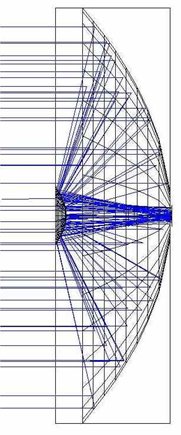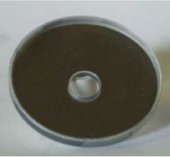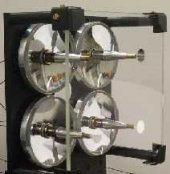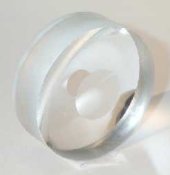
 Solar concentrators in general must meet the following requirements:
Solar concentrators in general must meet the following requirements:
Other fundamental requirements in the design of the optical fiber collector are the control of the image dimensions and the aperture angle that must be sized in order to be able to couple with the chosen optical component
(single fiber or fiber bundle).
In the case of the SPECTRUM project, the coupling considered was with a fiber with a numerical aperture N.A = 0.48 and a core diameter d = 0.6mm.
Three classes of optical collectors have been selected, analyzed and tested for this type of application.
 - Class A: also referred to as Mangin , are concentrators whose surfaces are spherical or flat. The Mangin system is composed of a glass meniscus, aluminized on the rear surface, and a secondary mirror which can be flat or spherical.
The optical path between the two surfaces of the meniscus allows to control the spherical aberrations, appropriately correcting the curvature radius.
- Class A: also referred to as Mangin , are concentrators whose surfaces are spherical or flat. The Mangin system is composed of a glass meniscus, aluminized on the rear surface, and a secondary mirror which can be flat or spherical.
The optical path between the two surfaces of the meniscus allows to control the spherical aberrations, appropriately correcting the curvature radius.
 - Class B: in this class there are systems with parabolic mirrors , which are also called parabolic concentrators or Paraboloids .
- Class B: in this class there are systems with parabolic mirrors , which are also called parabolic concentrators or Paraboloids .
Parabolic systems consist of two mirrors, in which the primary mirror is parabolic and the secondary mirror is flat. Possibly there may be a correction lens. The position of the secondary mirrors is similar to the corresponding Mangin type configurations.
 - Class C: the concentrators of this class have an original configuration called Monobloc Catadioptric Concentrator ( CCM ), which has been designed in order to optimize both the optical characteristics (collection efficiency, aberrations, etc.) and the compactness of the component to be manufactured (dimensions and weight).
- Class C: the concentrators of this class have an original configuration called Monobloc Catadioptric Concentrator ( CCM ), which has been designed in order to optimize both the optical characteristics (collection efficiency, aberrations, etc.) and the compactness of the component to be manufactured (dimensions and weight).
The optical principle of this collector consists of two optical elements in a coaxial configuration, similar to the Cassegrain one. The CCM is made in a single piece, this allows to obtain an object characterized by reduced dimensions and great mechanical stability. To increase efficiency, the CCM has aspherical surfaces, the realization of which requires the development of particular production procedures, which makes the realization of the component complex and expensive.
CNR-INO Istituto Nazionale di Ottica - Largo Fermi 6, 50125 Firenze - Tel. +39 05523081 - P.iva 02118311006 - Info: info@ino.cnr.it